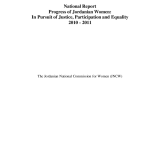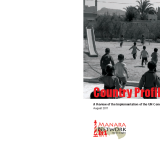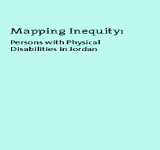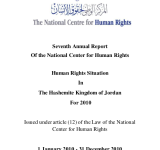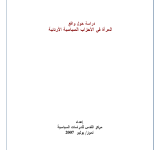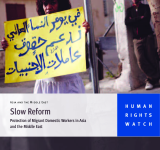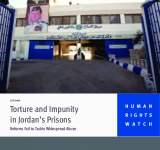This national report is designed to trace the progress of women in various fields;; monitoring achievements;; and highlighting gaps and failures;; as well as analyzing indicators;; recommending measures;; and measuring levels of achievements in the implementation of plans and strategies. The main themes were selected according to national priorities dictated by each stage: Legal Protection for Women's Right to Access Justice;; Participation;; the Economic Empowerment of Jordanian Women;; Equality;; Citizenship and Decision-Making in Public Life. The conclusions of this report confirm that a much smaller effort was exerted at the level of providing information;; data and the provision of services in the area of providing justice and facilitating ways of achieving it. The lack of knowledge about available services among women;; whether provided by civil society organizations or government institutions;; affects women's ability to access justice negatively. Regarding the economic participation the Policies and plans that targeted empowering women economically show that the result of these policies was weak and limited. Difficulty of women’s access to job opportunities in the private sector and inequitable pay between the sexes;; lack of supporting services to working women;; including childcare Facilities;; poor matching between education outputs and skills required in the labor market and the traditional social standards that contribute to directing females towards certain professions. The report proposed general recommendations and directions that include quick solutions to deal with the main highlighted challenges.
justice
The country profile component of the Manara project is a rigorous and exhaustive report on the status of the implementation of the Convention on the Rights of the Child. It aims to be a resource for identifying gaps and challenges on the status of the implementation of the Convention;; to highlight the recommendations of the Committee on the Rights of the Child on specific matters;; and to identify commendable practices implemented by the State;; civil society and the international community in addressing these issues. The information was collected by exhaustive literature review and followed by field research involving a series of interviews with identified stakeholders;; government ministries and institutions;; local and INGOs;; academics;; unions and professional associations;; media;; religious authorities and United Nations agencies were contacted and interviewed. The structure of the study is based on the following themes: human rights;; children’s rights;; child labor and violence against children
This report adopts a rights-based approach to map the access of persons with physical disabilities to social services in Jordan and assess the extent to which they enjoy equal opportunities and are socially integrated. The rights-based approach calls for a thorough assessment of the “4 A’s”;; i.e. the availability;; accessibility;; adaptability and acceptability of social services for all members of society. It thus puts special emphasis on the environmental factors and policy gaps constraining the “4 A’s” and preventing the social integration of vulnerable groups. Accordingly;; the objectives of this study are (a) to set forth the social;; legal and institutional barriers preventing persons with physical disabilities in Jordan from fully enjoying their right to education;; health;; employment and social protection and (b) to gauge the ability of social policies to lift these barriers and facilitate the overcoming of inequity for this group.
This annual report comes to diagnose the situation of human rights in the Hashemite Kingdom of Jordan in 2010;; and to point out the positive or negative changes that have occurred during that period. The report comprises the outcome of the accumulated experiences of the Center in the field of protecting civil;; political;; economic;; social and cultural rights. It also comprises a qualitative addition represented in the devotion of an axis related to the assessment of how serious the Government is in taking appropriate legislative;; judicial and executive measures needed to implement the recommendations by the treaty committees. The main themes are: Civil and Political Rights;; Economic;; Social and Cultural Rights;; Women's Rights;; Child Rights;; Rights of Persons with Disability;; Rights of the Elderly. The report proposes legislations;; policies and measures that are believed to contribute to changing the current situation of Human Rights for the better;; especially in the light of the rapid developments taking place in the Arab region.
هذا التقرير يستعرض جميع السياسات والتشريعات والممارسات والاجراءات الوطنية لبيان مدى اتفاقها مع الالتزامات المبنية في اتفاقية القضاء على جميع اشكال التمييز ضد المرأة;; بالاضافة إلى القاء الضوء على مساهمة المرأة في التنمية السياسية والاقتصادية والاجماعية. اضافة إلى ذلك;; فإن هذا الملخص يعرض الانجازات والتحديات ذات الصلة بحقوق المراة في مجال المساواة وعدم التمييز التي وردت في التقرير على صعيد: المشاركة في الحياة العامة;; محور التشريعات ;; محور الأمن البشري والحماية الاجتماعية;; ومحور التمكين الاقتصادي;; ومحور الاعلام.
دراسة مسحية استطلاعية حول واقع المرأة في الأحزاب السياسية الأردنية. وهذه الدراسة المسحية كانت من شقين: توزيع استبانة على عينة تضم 113 حزبية ينتمين الى 17 حزبا من أصل 35 حزباً سياسياً;; واجراء مقابلات مع عدد من الحزبيات حول واقع مشاركة المرأة في الأحزاب والمعيقات التي تواجهها. وفيما يتعلق بالجانب النظري للدراسة فإنه يستعرض المرأة في برامج الأحزاب السياسية الأردنية;; وشمل ذلك المرأة في ادبيات 18 حزباً من مختلف الاتجاهات. وقد أظهرت النتائج ضعف تمثيل المرأة في الاحزاب لعدة عوامل سياسية واجتماعية واقتصادية اضافة إلى عوامل تتعلق بالمراة ذاتها. وكما قدمت الدراسة مجموعة من التوصيات وكانت على أربعة مستويات: المجتمع الاردني;; والحكومة الأردنية;; والأحزاب الأردنية;; والمرأة نفسها.
يراجع التقرير أوضاع ثماني دول فيها أعداد كبيرة من عاملات المنازل المهاجرات;; هي لبنان والأردن والسعودية والكويت والإمارات والبحرين وسنغافورة وماليزيا. يعرض التقرير التقدم المحرز في توفير تدابير الحماية المتوفرة بموجب قوانين العمل لعاملات المنازل;; وإصلاح نظم "الكفالة" الخاصة بالهجرة والتي تسهم في الإساءة للعاملات;; وضمان فعالية استجابة الشرطة والمحاكم على العنف البدني والجنسي;; والسماح للمجتمع المدني والنقابات بالتنظيم.
يتضمن هذا التقرير تحليلاً موسعاً ومتكاملاً لمؤشرات الفقر بالاستناد الى بيانات مسح نفقات ودخل الأسرة لعام 2008;; الذي نفذته دائرة الاحصاءات العامة على أربع جولات ميدانية استمرت سنة;; والذي انتهى العمل به مع نهاية الربع الأول لعام 2009. وبناءاً على بيانات هذا المسح تم اعداد تقريرين سابقين: الأول كان فيه عرض للنتائج الرئيسية للمسح والآخر تناول قياس مؤشرات الفقر باستخدام منهجية السعرات الحرارية المعتمدة من قبل البنك الدولي ومقارنتها عبر الزمن بالأسعار الثابتة. وبناءاً عليه تم تم اعداد هذا التقرير التحليلي لحالة الفقر في الأردن;; وذلك بمشاركة العديد من الجهات الوطنية المعنية بالفقر. وكما يتناول التقرير تحليلاً للتدخلات الحكومية المباشرة بالأسعار الجارية خلال عام 2008 في الحد من ظاهرة الفقر.
